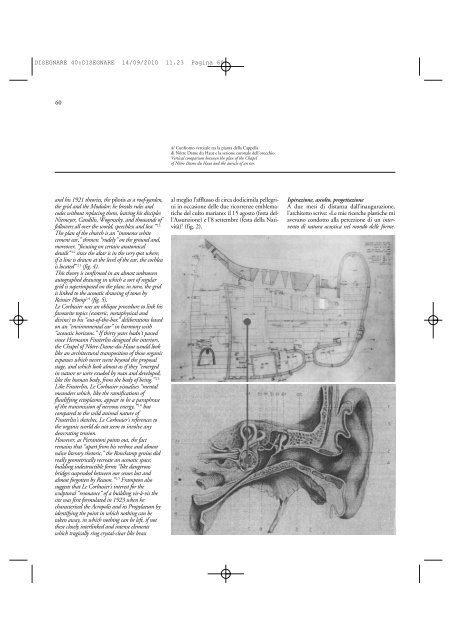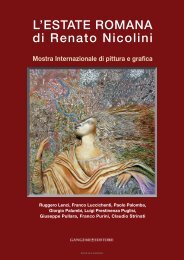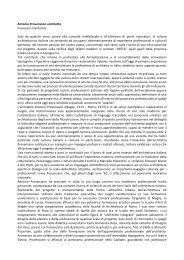Recondite Armonie - Archiwatch
Recondite Armonie - Archiwatch
Recondite Armonie - Archiwatch
You also want an ePaper? Increase the reach of your titles
YUMPU automatically turns print PDFs into web optimized ePapers that Google loves.
DISEGNARE 40:DISEGNARE 14/09/2010 11.23 Pagina 60<br />
60<br />
4/ Confronto verticale tra la pianta della Cappella<br />
di Nôtre Dame du Haut e la sezione coronale dell’orecchio.<br />
Vertical comparison between the plan of the Chapel<br />
of Nôtre Dame du Haut and the auricle of an ear.<br />
and his 1921 theories, the pilotis as a roof-garden,<br />
the grid and the Modulor; he breaks rules and<br />
codes without replacing them, leaving his disciples<br />
Niemeyer, Candilis, Wogenscky, and thousands of<br />
followers all over the world, speechless and lost.” 11<br />
The plan of the church is an “immense white<br />
cement ear,” thrown “rudely” on the ground and,<br />
moreover, “focusing on certain anatomical<br />
details” 12 since the altar is in the very spot where,<br />
if a line is drawn at the level of the ear, the cochlea<br />
is located” 13 (fig. 4).<br />
This theory is confirmed in an almost unknown<br />
autographed drawing in which a sort of regular<br />
grid is superimposed on the plan; in turn, the grid<br />
is linked to the acoustic drawing of tones by<br />
Reinier Plomp 14 (fig. 5).<br />
Le Corbusier uses an oblique procedure to link his<br />
favourite topics (exoteric, metaphysical and<br />
divine) to his “out-of-the-box” deliberations based<br />
on an “environmental ear” in harmony with<br />
“acoustic horizons.” If thirty years hadn’t passed<br />
since Hermann Finsterlin designed the interiors,<br />
the Chapel of Nôtre-Dame-du-Haut would look<br />
like an architectural transposition of those organic<br />
expanses which never went beyond the proposal<br />
stage, and which look almost as if they “emerged<br />
in nature or were exuded by man and developed,<br />
like the human body, from the body of being.” 15<br />
Like Finsterlin, Le Corbusier visualises “mental<br />
meanders which, like the ramifications of<br />
fluidifying ectoplasms, appear to be a paraphrase<br />
of the transmission of nervous energy,” 16 but<br />
compared to the wild animal nature of<br />
Finsterlin’s sketches, Le Corbusier’s references to<br />
the organic world do not seem to involve any<br />
desecrating tension.<br />
However, as Pierantoni points out, the fact<br />
remains that “apart from his verbose and almost<br />
naïve literary rhetoric,” the Ronchamp genius did<br />
really geometrically recreate an acoustic space,<br />
building indestructible forms “like dangerous<br />
bridges suspended between our senses lost and<br />
almost forgotten by Reason.” 17 Frampton also<br />
suggests that Le Corbusier’s interest for the<br />
sculptural “resonance” of a building vis-à-vis the<br />
site was first formulated in 1923 when he<br />
characterised the Acropolis and its Propylaeum by<br />
identifying the point in which nothing can be<br />
taken away, in which nothing can be left, if not<br />
these closely interlinked and intense elements<br />
which tragically ring crystal-clear like brass<br />
al meglio l’afflusso di circa dodicimila pellegrini<br />
in occasione delle due ricorrenze emblematiche<br />
del culto mariano: il 15 agosto (festa dell’Assunzione)<br />
e l’8 settembre (festa della Natività)<br />
5 (fig. 2).<br />
Ispirazione, ascolto, progettazione<br />
A due mesi di distanza dall’inaugurazione,<br />
l’architetto scrive: «Le mie ricerche plastiche mi<br />
avevano condotto alla percezione di un intervento<br />
di natura acustica nel mondo delle forme.






